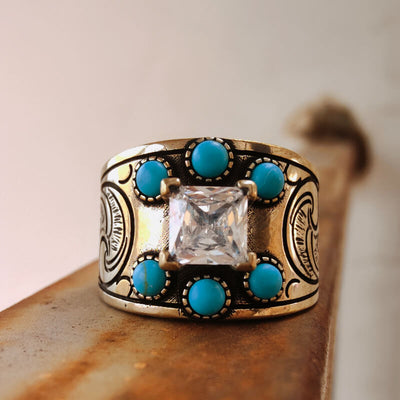Uncover the Timeless Allure of Turquoise Engagement Rings: A Journey Through Meaning and History
In recent years, turquoise engagement rings have surged in popularity, captivating couples with their vibrant hues and unique charm. Unlike traditional diamonds, turquoise offers a refreshing alternative that reflects individuality and creativity. The striking blue-green color of turquoise, often interspersed with intricate veining, creates a gemstone that is as enchanting as it is meaningful. As more people seek to express their love through personalized choices, turquoise engagement rings are becoming a symbol of a deeper connection, representing a story that goes beyond the conventional.

The Unique Attributes of Turquoise Engagement Rings
Turquoise is a captivating gemstone renowned for its stunning color variations that range from a bright sky blue to a soft greenish hue. The physical properties of turquoise add to its allure; being a relatively soft stone, it is easier to carve and set into intricate designs. This quality allows for a range of artistic expressions in engagement rings, whether it be a simple solitaire or a complex vintage-inspired setting. Additionally, turquoise is often found with unique veining patterns, which means that no two stones are alike. These characteristics make turquoise a compelling choice for engagement rings, as each piece tells a story of its own. Friends of mine who have chosen turquoise rings often love how their rings reflect their personalities—one friend has a ring with deep blue swirls, while another's features a more muted, earthy tone, perfectly matching their distinct styles.
Symbolism and Meaning Behind Turquoise
Throughout history, turquoise has been imbued with rich symbolism and cultural significance. In many cultures, turquoise is believed to offer protection and promote healing. Native American tribes, for instance, consider turquoise a sacred stone that symbolizes strength, wisdom, and friendship. In ancient Egypt, turquoise was associated with the goddess Hathor, representing love and joy. The stone's connection to fidelity and everlasting love has made it a popular choice for engagement rings. Many couples appreciate the symbolism of turquoise as a gemstone that not only signifies love but also embodies a protective charm for their relationship. This deeper meaning resonates with those who cherish the idea of wearing a ring that represents not just a commitment, but also a bond that nurtures love and loyalty through life’s journey.
The History of Turquoise in Jewelry
The history of turquoise in jewelry is a fascinating journey that spans thousands of years. Its use dates back to ancient civilizations, with the Egyptians crafting beautiful pieces adorned with the stone, believing it to be a gift from the gods. In Native American culture, turquoise holds immense significance, often used in ceremonial objects and jewelry. It has been a part of their heritage for centuries, symbolizing connection to the earth and sky. As cultures evolved, so did the designs and popularity of turquoise in jewelry. In the 19th century, turquoise gained renewed popularity in the West, especially after the discovery of vast deposits in the American Southwest. Its vibrant colors and unique aesthetic made it a favored choice among jewelers and artisans, leading to the creation of exquisite turquoise engagement rings that combine tradition with modern elegance. The evolution of turquoise in jewelry reflects a rich tapestry of cultural significance, making it not only a beautiful choice but a historically meaningful one.
Choosing a Turquoise Engagement Ring
When it comes to selecting a turquoise engagement ring, several factors should be taken into consideration to ensure the perfect choice. Quality is paramount; look for stones with a rich color and minimal inclusions, as these attributes enhance the beauty and value of the ring. The cut of the turquoise can also influence its appearance, with cabochon cuts often showcasing the stone’s natural patterns beautifully. The setting is equally important—turquoise pairs well with various metals, such as gold or silver, which can complement its vibrant colors. Additionally, personal style and preferences should guide your choice. Whether you prefer a modern minimalist design or a bohemian ornate piece, selecting a turquoise ring that resonates with your individual taste will create a meaningful and cherished symbol of love.
Celebrating the Elegance of Turquoise Engagement Rings
Turquoise engagement rings offer a timeless allure that blends beauty with rich symbolism and history. As couples seek more personalized expressions of their love, turquoise stands out as a meaningful alternative to traditional gemstones. Its unique attributes, historical significance, and the deep connections it fosters make it an exceptional choice for those looking to celebrate their commitment in a distinctive way. Consider turquoise not just as a beautiful gemstone, but as a representation of your unique love story, perfect for an engagement ring that is truly one-of-a-kind.







commentaires